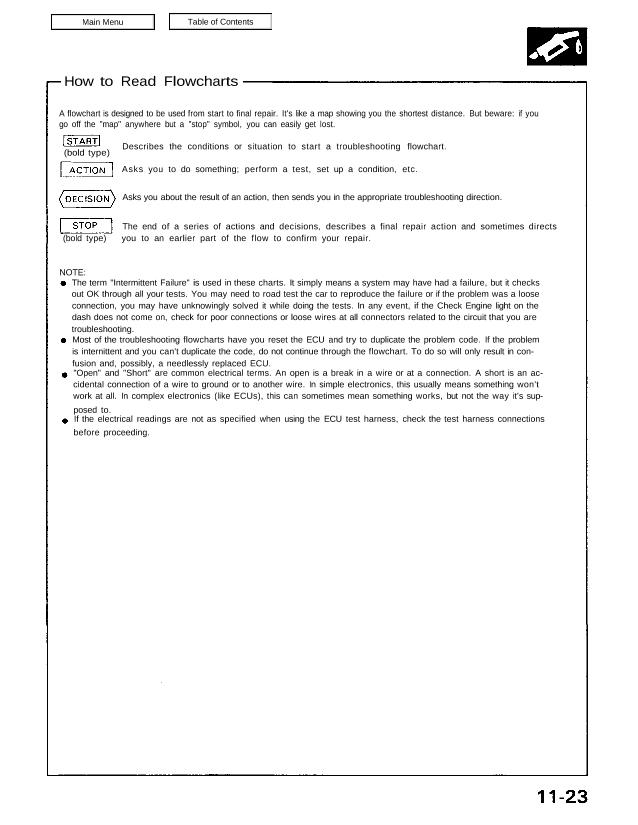How to Read Flowcharts
A flowchart is designed to be used from start to final repair. It’s like a map showing you the shortest distance. But beware: if you
go off the “map” anywhere but a “stop” symbol, you can easily get lost.
Describes the conditions or situation to start a troubleshooting flowchart.
(bold type)
Asks you to do something; perform a test, set up a condition, etc.
Asks you about the result of an action, then sends you in the appropriate troubleshooting direction.
The end of a series of actions and decisions, describes a final repair action and sometimes directs
(bold type) you to an earlier part of the flow to confirm your repair.
NOTE:
The term “Intermittent Failure” is used in these charts. It simply means a system may have had a failure, but it checks
out OK through all your tests. You may need to road test the car to reproduce the failure or if the problem was a loose
connection, you may have unknowingly solved it while doing the tests. In any event, if the Check Engine light on the
dash does not come on, check for poor connections or loose wires at all connectors related to the circuit that you are
troubleshooting.
Most of the troubleshooting flowcharts have you reset the ECU and try to duplicate the problem code. If the problem
is internittent and you can’t duplicate the code, do not continue through the flowchart. To do so will only result in con-
fusion and, possibly, a needlessly replaced ECU.
“Open” and “Short” are common electrical terms. An open is a break in a wire or at a connection. A short is an ac-
cidental connection of a wire to ground or to another wire. In simple electronics, this usually means something won’t
work at all. In complex electronics (like ECUs), this can sometimes mean something works, but not the way it’s sup-
posed to.
If the electrical readings are not as specified when using the ECU test harness, check the test harness connections
before proceeding.
A flowchart is designed to be used from start to final repair. It’s like a map showing you the shortest distance. But beware: if you
go off the “map” anywhere but a “stop” symbol, you can easily get lost.
Describes the conditions or situation to start a troubleshooting flowchart.
(bold type)
Asks you to do something; perform a test, set up a condition, etc.
Asks you about the result of an action, then sends you in the appropriate troubleshooting direction.
The end of a series of actions and decisions, describes a final repair action and sometimes directs
(bold type) you to an earlier part of the flow to confirm your repair.
NOTE:
The term “Intermittent Failure” is used in these charts. It simply means a system may have had a failure, but it checks
out OK through all your tests. You may need to road test the car to reproduce the failure or if the problem was a loose
connection, you may have unknowingly solved it while doing the tests. In any event, if the Check Engine light on the
dash does not come on, check for poor connections or loose wires at all connectors related to the circuit that you are
troubleshooting.
Most of the troubleshooting flowcharts have you reset the ECU and try to duplicate the problem code. If the problem
is internittent and you can’t duplicate the code, do not continue through the flowchart. To do so will only result in con-
fusion and, possibly, a needlessly replaced ECU.
“Open” and “Short” are common electrical terms. An open is a break in a wire or at a connection. A short is an ac-
cidental connection of a wire to ground or to another wire. In simple electronics, this usually means something won’t
work at all. In complex electronics (like ECUs), this can sometimes mean something works, but not the way it’s sup-
posed to.
If the electrical readings are not as specified when using the ECU test harness, check the test harness connections
before proceeding.
